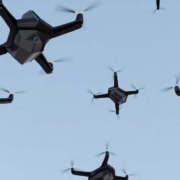Our Future (Cohabitation) with Robots: Are Drones Safe?
 by Hashem Izadi Moud, PhD
by Hashem Izadi Moud, PhD
Over 70 years ago, two decades before Neil Armstrong’s first small step and mankind’s giant leap on the moon, legendary science fiction author Isaac Asimov warned us about what would be coming. Asimov envisioned a robotic future; a future in which robots brought countless benefits not free of challenges however.
Knowing the benefits that robots could bring to our future – but with some serious side effects – in 1942, Asimov introduced the Three Laws of Robotics:
- First Law: A robot may not injure a human being or, through inaction, allow a human being to come to harm.
- Second Law: A robot must obey the orders given it by human beings except where such orders would conflict with the First Law.•
- Third Law: A robot must protect its own existence as long as such protection does not conflict with the First or Second Law.
Almost 80 years after Asimov’s inscription of laws of robotics, my colleagues and I at Florida Gulf Coast University’s (FGCU)Department of Construction Management are working diligently to address some of the challenges that robots and automated machines have brought.
As a drone enthusiast, I dedicated most of my research to the challenges that drones, these small (semi) autonomous robots, have introduced to the general public.
In a market that is loosely regulated, with little known about hazards and risks that flying drones pose to humans on the ground, we, at FGCU, are working tirelessly towards enhancing the safety of drone flights.
We started with the big question: Are drones safe to fly over populated urban environments? As a drone ages, its flight reliability decreases. Aging impacts the safety of the drones and the duration of its flights.
Surprisingly, because there are not many old (aged) drones around – due to their relatively new presence – there is not much data available on how the reliability of drones changes over their lifetime. Our research answered this question and we developed the – first ever known – mathematical models that can predict the safety and reliability of flying drones in populated urban environments.
Our research will play a major role, in the future, in reinforcement of the safety of drones. Our research also investigates other concerning issues associated with drones such as privacy concerns and noise complaints.
Is it possible to make a complaint against a drone flying on your association’s airspace? Do we have control over our home’s airspace? Can we use mathematical models to plan drones flight paths that minimize the noise disturbances?
Our team has addressed a few of these questions and diligently works towards finding answers to other issues. In our latest effort, we are investigating drone flight path planning based on humans’ auditory response. We develop models that enable drone flight crews to find the optimum flight path in national airspace with the least noise disturbance for families living in the area.
Why do we think this research will be important for Florida residents in the future? Just imagine it is 2030, and there is going to be a new drone highway built above your community in Naples. You have no control over your airspace as we generally own the land, not the airspace above it.
Researchers like me provide alternatives for drone flight crews to map flight paths with zero disturbance for you and your community! We provide solutions to maximize safety and minimize the disturbance of drone flights for people in our community by embracing Asimov’s First Law of Robotics. That is what we do at FGCU; saving your home (the eagle’s nest).
Go Eagles! Foundation




Leave a Reply
Want to join the discussion?Feel free to contribute!